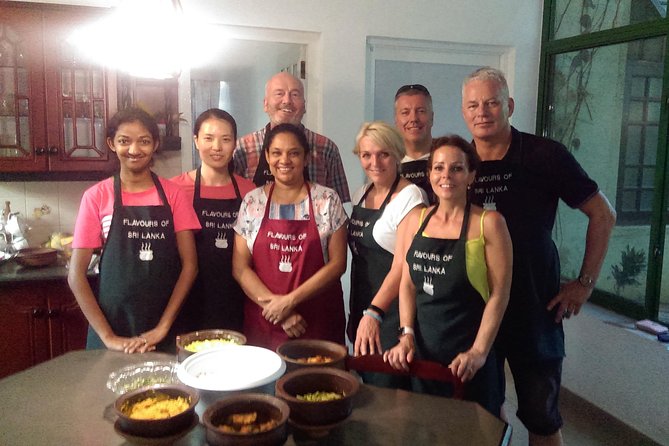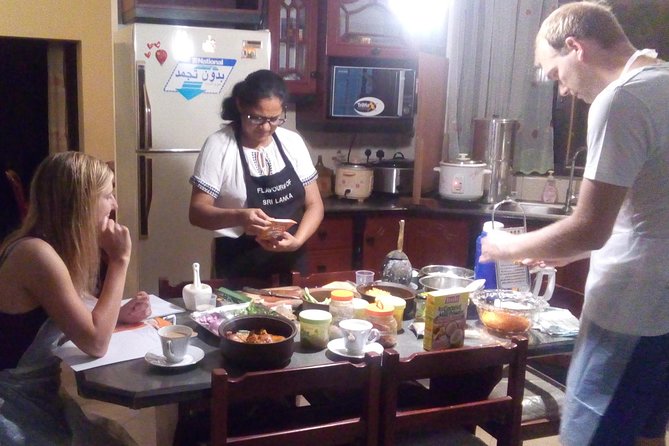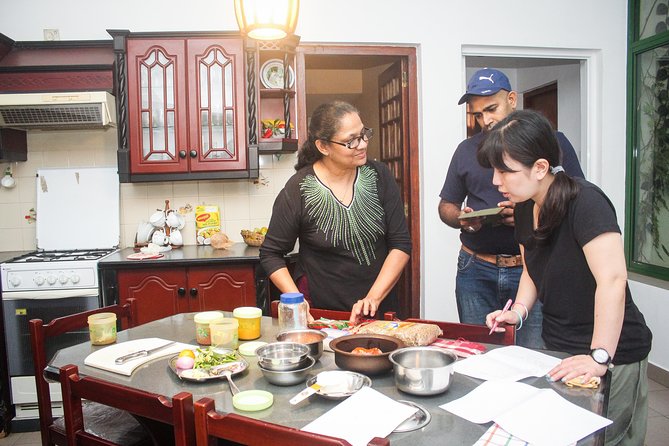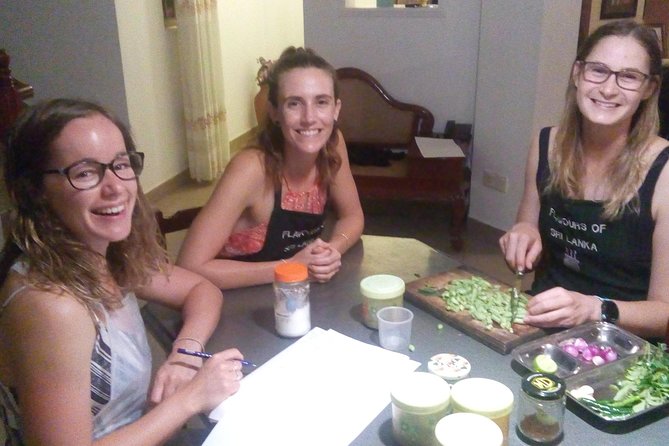The flavors of Sri Lanka offer a unique culinary journey that blends ancient traditions with diverse influences. From the warming essence of spices like cinnamon and cardamom to the rich presence of coconut, each dish tells a story of community and celebration. Signature meals such as rice and curry or kottu roti not only satisfy the palate but also evoke a sense of nostalgia. As one explores the vibrant tapestry of these culinary delights, it becomes clear that there’s much more to uncover about the art and culture behind Sri Lankan cuisine.
Good To Know

- Sri Lankan cuisine features a rich blend of ancient traditions and colonial influences, showcasing unique flavors and ingredients.
- Fresh spices like cinnamon, cardamom, and curry leaves are essential, enhancing the depth of Sri Lankan dishes.
- Signature dishes include rice and curry, hoppers, and kottu roti, each invoking warmth and nostalgia.
- Coconut is a key ingredient, used in various forms to elevate flavors and create distinct relishes like pol sambol.
- Culinary experiences often involve hands-on cooking classes, emphasizing fresh, local ingredients and community connection through shared meals.
Unique Culinary Heritage

In the heart of the Indian Ocean, Sri Lanka boasts a culinary heritage that’s as vibrant as its landscapes. This island nation’s cuisine reflects a blend of influences, from ancient traditions to colonial encounters.
With an emphasis on fresh ingredients, Sri Lankan cooking often highlights spices like cinnamon, cardamom, and curry leaves, creating rich, aromatic dishes. The use of coconut in various forms—milk, oil, and grated—enhances the flavors, making each meal a sensory delight.
Street vendors and home cooks alike take pride in their recipes, passed down through generations. This hands-on approach not only preserves culture but also brings communities together, celebrating the unique essence of Sri Lankan food that captivates both locals and visitors alike.
You can also read our reviews of more tours and experiences in Kandy.
Traditional Sri Lankan Dishes

Sri Lanka’s culinary landscape is a vibrant tapestry of traditional dishes that reflect its rich cultural heritage. Each meal tells a story, blending flavors and ingredients that speak to the island’s history and traditions.
| Dish | Description |
|---|---|
| Rice and Curry | A staple meal with various curries; it’s comforting and flavorful. |
| Hoppers | Bowl-shaped pancakes made from rice flour; often served with egg or meat. |
| Kottu Roti | Stir-fried flatbread mixed with vegetables and meat; it’s a street food favorite. |
| Pol Sambol | A fresh coconut relish that adds zest to any meal. |
These dishes not only satisfy the palate but also connect people, invoking warmth and nostalgia as families gather around the table to share their love for food.
Cooking Class Experience
Exploring the vibrant flavors of Sri Lankan cuisine goes beyond just tasting; it’s about experiencing the art of cooking these beloved dishes firsthand.
In a small-group cooking class led by Chitra, participants dive into the culinary traditions of Sri Lanka. With a maximum of eight travelers, everyone receives personalized attention while learning to prepare an array of traditional dishes, including lentils and jackfruit curry.
The hands-on approach ensures that students engage in every step, from brewing a cup of Ceylon tea to savoring their creations alongside fellow participants.
The experience culminates in a communal meal, fostering connections over delightful flavors. For just $35, this culinary journey offers an authentic taste of Sri Lanka, making it a must-try for foodies.
Ingredient Sourcing Techniques
One key aspect of mastering Sri Lankan cuisine lies in the sourcing of fresh ingredients, and this cooking class takes participants on a delightful journey to discover just that.
From the vibrant home garden to the bustling local markets, participants learn the importance of quality ingredients.
Here are three essential sourcing techniques they’ll explore:
-
Home Garden Visits: Picking fresh vegetables and herbs straight from the source enhances flavor and freshness.
-
Coconut Mastery: Participants practice cracking coconuts and extracting milk, a staple in many dishes.
-
Local Market Exploration: Discovering seasonal produce and spices at local markets fosters a deeper connection to Sri Lankan culinary traditions.
These techniques not only elevate the dishes but also cultivate an appreciation for Sri Lanka’s rich agricultural heritage.
The Art of Sri Lankan Spices

Understanding the role of spices is vital to unlocking the flavors of Sri Lankan cuisine. These vibrant ingredients, like cinnamon, cardamom, and cloves, create a symphony of tastes that define the island’s culinary identity.
Sri Lankans have mastered the art of blending spices, often toasting them to enhance their natural oils and flavors. This meticulous process transforms simple dishes into rich, aromatic feasts.
Each spice tells a story, reflecting the island’s history and cultural influences, from ancient trade routes to colonial encounters. Locals often grow their spices, ensuring freshness and authenticity.
Dining Experience Overview
What makes a dining experience truly memorable? It’s the blend of flavors, the company, and the stories shared.
In Sri Lanka, this dining experience celebrates the island’s rich culinary heritage. Here are three highlights:
-
Culinary Diversity: From lentil curry to sweet and sour mango, every bite tells a story of tradition.
-
Hands-On Learning: Participants engage in preparing their meal, making it personal and interactive.
-
Community Connection: Sharing the table with fellow students fosters a sense of camaraderie and cultural exchange.
As guests savor their creations alongside their instructor, they not only enjoy a meal but also enjoy the vibrant tapestry of Sri Lankan culture, making every moment unforgettable.
Reviews and Testimonials
The dining experience is often enriched by the voices of those who have participated, providing a glimpse into the joy and satisfaction that comes from a cooking class in Sri Lanka. With an impressive overall rating of 5.0 stars from six reviews, participants rave about the personal touch and authenticity of the sessions led by Chitra. Many express how the hands-on approach and fresh ingredients made the meals unforgettable.
| Reviewer | Comment |
|---|---|
| Sarah | "An amazing experience, highly recommend!" |
| Mark | "Loved learning about the spices!" |
| Elena | "The best way to experience Sri Lankan culture!" |
| Tom | "Delicious food and great company!" |
These testimonials reflect the vibrant culinary journey awaiting future attendees.
Practical Information and Pricing
Discovering the practical details of the Sri Lankan cooking class makes planning your culinary adventure a breeze. Here’s what you need to know:
-
Pricing: Classes start at just $35.00, with a lowest price guarantee.
-
Location: The meeting point is Glory Homestay, Kandy, conveniently accessible by public transport.
-
Cancellation Policy: Enjoy peace of mind with free cancellation available up to 24 hours before the class begins.
Participants experience hands-on cooking with fresh ingredients from the local garden.
Classes run from 03:30 pm and are designed for small groups, ensuring personalized attention.
With an overall rating of 5.0 stars from previous attendees, this class promises not just a meal, but a memorable culture in the flavors of Sri Lanka.
Frequently Asked Questions
What Dietary Restrictions Can Be Accommodated During the Cooking Class?
During the cooking class, Chitra accommodates various dietary restrictions, including vegetarian, vegan, and gluten-free options. She’s committed to ensuring everyone enjoys the experience while appreciating the rich culinary traditions of Sri Lankan cuisine.
How Long Is the Cooking Class Duration?
The cooking class lasts approximately three hours. Participants dive deep into hands-on cooking, learning traditional techniques while enjoying a cozy atmosphere that encourages cultural exchange and appreciation for the rich culinary heritage being explored.
Is Transportation Provided to and From the Class?
Transportation isn’t provided to and from the cooking class. Participants should plan their own transportation. However, the meeting point is conveniently located near public transport, making it easy for everyone to access the experience.
Can Children Participate in the Cooking Class?
Yes, children can participate in the cooking class. Chitra warmly welcomes families, ensuring a fun, educational experience. Kids enjoy hands-on cooking, learning about traditional dishes while creating lasting memories alongside their parents and fellow classmates.
What Should I Bring to the Cooking Class?
For the cooking class, participants should bring an apron, a water bottle, and a notebook for recipes. Chitra encourages everyone to wear comfortable clothing and a smile, ready to enjoy a delightful culinary experience together.
The Sum Up
To sum it up, exploring the flavors of Sri Lanka is like embarking on a delicious journey through its rich culinary heritage. From the fragrant spices to the heartwarming traditional dishes, each bite tells a story that connects people, culture, and history. Whether it’s taking a cooking class or savoring a meal with loved ones, the experiences are sure to leave lasting memories. So, why not dive into this vibrant world of taste and celebrate the enchanting flavors Sri Lanka has to offer?
More Tour Reviews in Kandy
- Sri Lanka: 6-DayTour of Kandy-Nuwara Eliya-Bentota & Colombo
- From Nuwara Eliya To Kandy Drop Tour
- From Colombo or Negombo: Pinnawala, Kandy & Tea Factory Tour
- From Colombo: Kandy, Pinnawala and Tea Factory Full-Day Trip
- Kandy City Tour by Tuk Tuk with hotel Pickup and Dropoff
- 6 Days of Sri Lanka with all inclusive Ayurvedha Uplift
Not for you? Here's more nearby things to do in Kandy we have reviewed
- Sri Lanka: 6-DayTour of Kandy-Nuwara Eliya-Bentota & Colombo
- From Nuwara Eliya To Kandy Drop Tour
- From Colombo or Negombo: Pinnawala, Kandy & Tea Factory Tour
- From Colombo: Kandy, Pinnawala and Tea Factory Full-Day Trip
- Kandy City Tour by Tuk Tuk with hotel Pickup and Dropoff
- 6 Days of Sri Lanka with all inclusive Ayurvedha Uplift
- Kandy Esala Perahera (2025 July-30 – 2025 Aug-09)
- Private Kandy City Tuk-Tuk Tour and Cultural Dance Show
- Kandy: City Tuk-Tuk Day Tours with a Local Guide
- From Kandy: Sigiraya Day Tour
- Kandy City Tour: UNESCO heritage city and temple visit
- Kandy to Ambuluwawa Tower, Pinnawala, Full Day Tour
